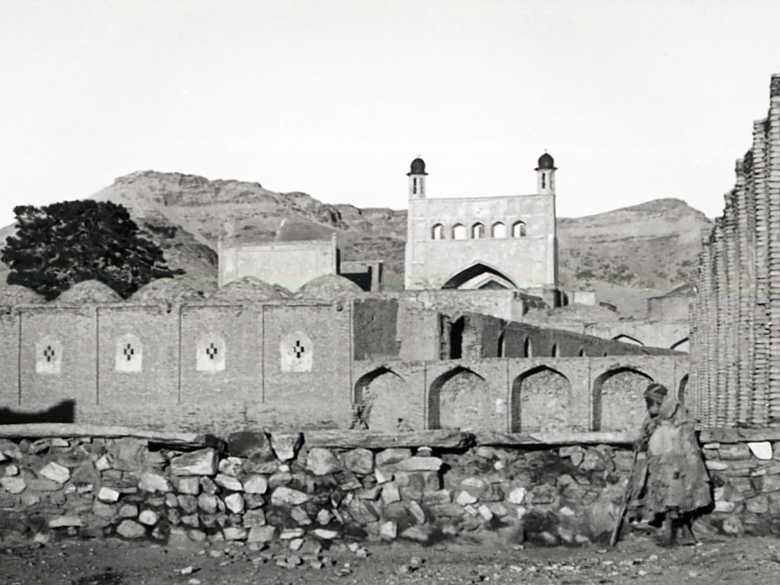RS 391 — Der Aussenhof von Gazergah
|RS 391-1|
Der Aussenhof wurde erst in neuerer Zeit gegen Westen durch die einstöckige, geschlossene Wand einer Gebetshalle abgeschlossen.
[Filmverzeichnis:] Eingangspartie.
- R. Stuckert (1994): Erinnerungen an Afghanistan, S. 66–67.
- C. E. Yate (1888): Northern Afghanistan or Letters from the Afghan Boundary Commission, S. 33–34: “[…] The shrine is distinguishable from afar by the huge lofty square-topped mass of building over a high arch—the usual feature of all sacred buildings in this part of the world. The shrine is well worth a visit, if only to see the simple yet handsome tomb of the Amir Dost Muhammad, and the handsome carved marble-work on the tomb of the saint, Kwajah Abdullah Ansari. Passing first through a large walled garden of pine and mulberry trees, the visitor comes to an octagonal-shaped domed building, full of little rooms and three-cornered recesses, two or three storeys in height, all opening inwards—built apparently as a cool breezy place in which to pass the heat of the summer days. Beyond this, again, is the main enclosure of the ziarat, now a deserted and dilapidated-looking place. Everything wears a look of decay: the unkempt courtyard, the broken tile-work on the archway and entrance to the shrine, and general want of repair visible everywhere, betoken a great falling off from former prosperity. […]”
- L. Golombek (1969): The Timurid Shrine at Gazur Gah, S. 22: “Aesthetically and functionally the entrance-complex is a self-contained building. This fact is reflected in the treatment of the outer walls of the Shrine. On the north […] the tile revetment stops abruptly at the conclusion of the lateral facade. The rest of the wall, which coincides with the length of the courtyard, has been left bare. Properly speaking, these lateral portals belong to the north and south sides of the Shrine, but they have been distinguished from the rest of the wall by a differentiation in the treatment of the surface. Through the facade, the portals were identified as part of the entrance-complex. […]”
- L. W. Adamec (1975): Herat and northwestern Afghanistan, S. 133: Gazargah.
- D. Brandenburg (1977): Herat, S. 41–42: zur Geschichte des Wallfahrtortes.
- R. Samizay (1981): Islamic Architecture in Herat, S. 64: “During the life of Abdullah Ansari, his friends, relatives, and disciples, used to go to Gazargah to visit the sacred Sufi. It was in Gazargah where Abdullah Ansari, his friends and relatives were subsequently buried. From then on, the place was sanctified and the most best-known holy men from other places were brought there to be buried as well.”
“But, it seems that the first burial that took place in the area was that of the bodies in the Haft Chah. The second shrine in Gazargah was the tomb of Sheikh Amawia that attracted many pilgrims. Khwaja Abdullah Ansari's tomb was the third and the most important shrine, that subsequently drew most of the dedicated believers and pilgrims to Gazargah.”
“Khwaja Ansari was born in a small house in the Kuhandazh of Herat. He is reported to have had a very unhappy childhood and had to leave his home town twice under pressures from his adversaries. After completing his education, he did extensive travelling going from town to town and village to village in order to gain insight and experience. Towards the end of his life he chose a solitary existence returning to Herat to dedicate his total time to contemplation and writing.” - W. Ball (1981): Archaeological Gazetteer of Afghanistan, S. 103–104: Gazurgah.
- T. Allen (1981): A Catalogue of the Toponyms and Monuments of Timurid Herat, S. 67 und S. 177.
- M. Fadaeian (2006): Herat Yesterday Today, S. 89–115: Khaje Abdullah Ansari.
Image No.
RS 391
Collection
Rudolf Stuckert 1940-1946
Series
RS 387-412, Herat, Gazergah
Format
Originalabzug 43/58 mm
Quality
sehr gut
Place, date
Herat, 1942
Descriptors
Latitude / Longitude34.373770 / 62.239240
Google Mapshttps://maps.google.com
Zoom Earthhttps://zoom.earth
You know more about this picture?





